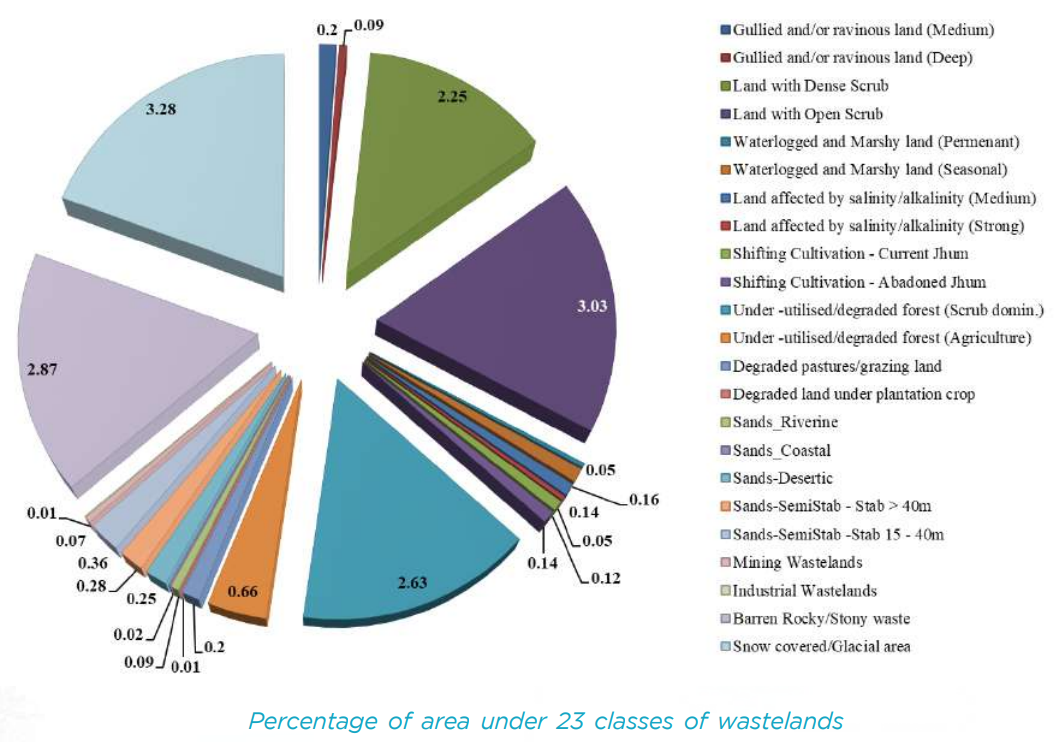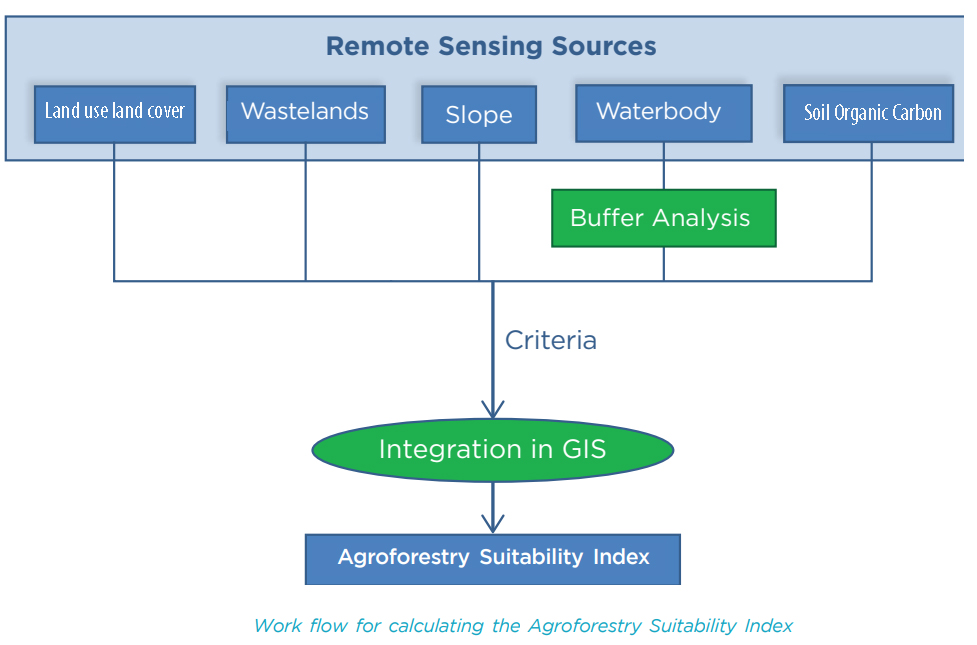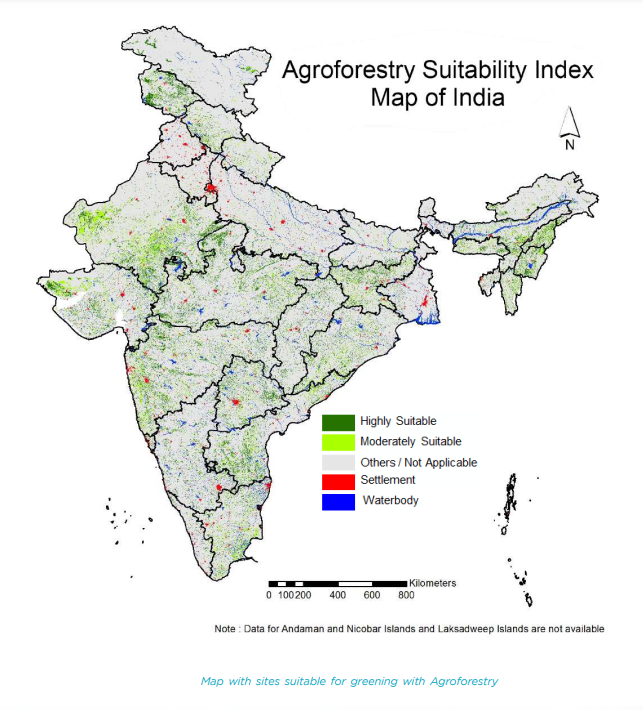NITI Aayog GROW Report and Portal | 02 Mar 2024
For Prelims: GROW Portal, Geographic Information System(GIS), Agroforestry Suitability Index, Agroforestry, Sub-Mission on agroforestry , National Agroforestry Policy (NAP) 2014, Bhuvan platform
For Mains: Agroforestry - Significance and Challenges, Government Policies & Interventions
Why in News?
Recently, the Greening and Restoration of Wasteland with Agroforestry (GROW) report and portal was launched by NITI Aayog (National Institution for Transforming India).
What are the Key Highlights of the GROW Report?
- GROW Report Objective:
- The GROW report aims to facilitate restoration projects for achieving national commitments of Land Degradation Neutrality and restoring 26 million hectares of degraded land by 2030, as well as creating an additional carbon sink of 2.5 to 3 billion tonnes of carbon dioxide equivalent.
- Extent of Wastelands in India:
- The report highlights that India possesses approximately 55.76 million hectares of wastelands, comprising 16.96% of the total geographical area (TGA) of the country.
- These degraded lands have suffered from reduced productivity and biodiversity due to various natural and human-induced factors. However, the report suggests greening and restoring these wastelands through agroforestry.
- Agroforestry as a Solution:
- The report also underscores the potential benefits of converting underutilised areas, especially wastelands, for agroforestry.
- Currently, agroforestry covers 8.65% of India's total geographical area, totalling about 28.42 million hectares and about 6.18% and 4.91% of India’s land are highly and moderately suitable for agroforestry, respectively.
- As per Indian Space Research Organisation (ISRO) Rajasthan, Madhya Pradesh, and Telangana are the top large-sized states for agroforestry suitability, while Jammu and Kashmir, Manipur, and Nagaland ranked highest among the medium-sized states.
- The report identifies the policy and institutional support required for scaling up agroforestry interventions in wastelands.
- The report also underscores the potential benefits of converting underutilised areas, especially wastelands, for agroforestry.
- Policy Framework:
- The report emphasises India's National Agroforestry Policy of 2014, which aims to enhance productivity, profitability, and sustainability through this agro ecological land use system.
- This aligns with global commitments like the Paris Agreement, Bonn Challenge, UN Sustainable Development Goals, United Nations Convention on Combating Desertification (UNCCD), Green India Mission and more.
- The report emphasises India's National Agroforestry Policy of 2014, which aims to enhance productivity, profitability, and sustainability through this agro ecological land use system.
What is the GROW Portal?
- The GROW portal is hosted on the Bhuvan platform, ensuring universal access to state and district-level data related to agroforestry suitability.
- Through the portal, users can access detailed maps and assessments of agroforestry suitability across different regions of India.
- The portal utilises thematic datasets derived from remote sensing and Geographic Information System (GIS) technology, offering comprehensive information on factors influencing agroforestry suitability.
- One of the key features of the portal is the Agroforestry Suitability Index (ASI), which provides a standardised index for prioritising agroforestry interventions at the national level.
- The portal offers insights into the current extent of agroforestry in India, highlighting its geographical spread and total coverage.
What is Agroforestry?
- About:
- Agroforestry is a land use management system that combines trees and shrubs with crops and livestock. It combines agricultural and forestry technologies to create more sustainable land-use systems.
- Agroforestry has been an integral part of Indian agriculture, fulfilling diverse needs such as wood demand, fuelwood, fodder, and subsistence requirements.
- Agroforestry is practised by both small and marginal farmers in rainfed conditions and large farmers under irrigated conditions, albeit with variations in adoption rates.
- Evolution of Agroforestry Policies and Initiatives:
- The initiation of All India Coordinated Research Project (AICRP) on Agroforestry in 1983 marked the formal integration of agroforestry into agricultural and forestry research agendas.
- Major policy initiatives in India, such as the National Forest Policy 1988, the National Agriculture Policy 2000, National Bamboo Mission 2002, National Policy on Farmers 2007, and Green India Mission 2010, have consistently highlighted the importance of agroforestry.
- Agroforestry gained momentum after India adopted the National Agroforestry Policy (NAP) 2014.
- The NAP is a policy framework that aims to improve agricultural livelihoods by integrating trees, crops, and livestock into the same plot of land. The policy was launched in February 2014 during the World Congress on Agroforestry, held in Delhi.
- India became the first country in the world to adopt a comprehensive agroforestry policy in 2014.
- As a follow- up to the policy, the Sub-Mission on agroforestry (SMAF) under National Mission for Sustainable Agriculture (NMSA) was launched in 2016-17 to encourage and expand tree plantation on farmland, with the motto of “Har Medh Par Ped”, along with crops/ cropping system.
- Impacts of Agroforestry:
- Economic Impact:
- Agroforestry systems demonstrate positive yield growth for fruits, timber, and crops, contributing to enhanced agricultural productivity.
- Agroforestry proves economically viable, offering additional income streams from diversified livelihood sources, including timber, fuelwood, and fodder.
- Social Impact:
- Agroforestry systems, particularly those emphasizing fruit crops, contribute to improved nutrition and health status among communities.
- While women's participation in agroforestry is significant, there's a need for further research to understand the impact of agroforestry on gender dynamics and women's empowerment.
- Environmental Impact:
- Agroforestry enhances soil fertility, nutrient cycling, and soil organic carbon, contributing to sustainable land management practices.
- Agroforestry systems improve water-use efficiency, mitigate soil erosion, and contribute to watershed management and conservation efforts.
- Agroforestry serves as a significant source of biomass energy while also sequestering carbon, aiding in climate change mitigation efforts.
- Agroforestry promotes biodiversity conservation by providing habitat, supporting species movement, and reducing deforestation rates.
- Economic Impact:
UPSC Civil Services Examination, Previous Year Questions (PYQs)
Prelims:
Q. How is permaculture farming different from conventional chemical farming?
- Permaculture farming discourages monocultural practices but in conventional chemical farming, monoculture practices are predominant.
- Conventional chemical farming can cause an increase in soil salinity but the occurrence of such phenomenon is not observed in permaculture farming.
- Conventional chemical farming is easily possible in semi-arid regions but permaculture farming is not so easily possible in such regions.
- Practice of mulching is very important in permaculture farming but not necessarily so in conventional chemical farming.
Select the correct answer using the code given below:
(a) 1 and 3
(b) 1, 2 and 4
(c) 4 only
(d) 2 and 3
Ans: (b)
Q.2 Which of the following is the chief characteristic of ‘mixed farming’? (2012)
(a) Cultivation of both cash crops and food crops
(b) Cultivation of two or more crops in the same field
(c) Rearing of animals and cultivation of crops together
(d) None of the above
Ans: (c)
Q. The Government of India has established NITI Aayog to replace the (2015)
(a) Human Rights Commission
(b) Finance Commission
(c) Law Commission
(d) Planning Commission
Ans: (d)
Mains
Q.1 What are the present challenges before crop diversification? How do emerging technologies provide an opportunity for crop diversification? (2021)



